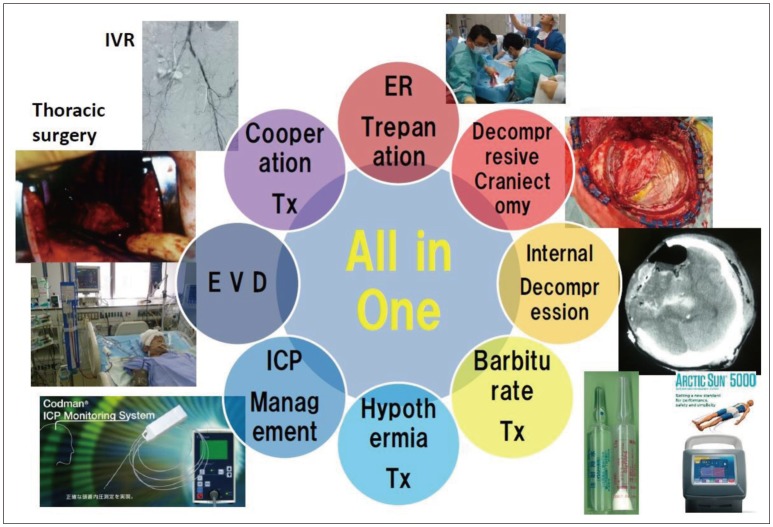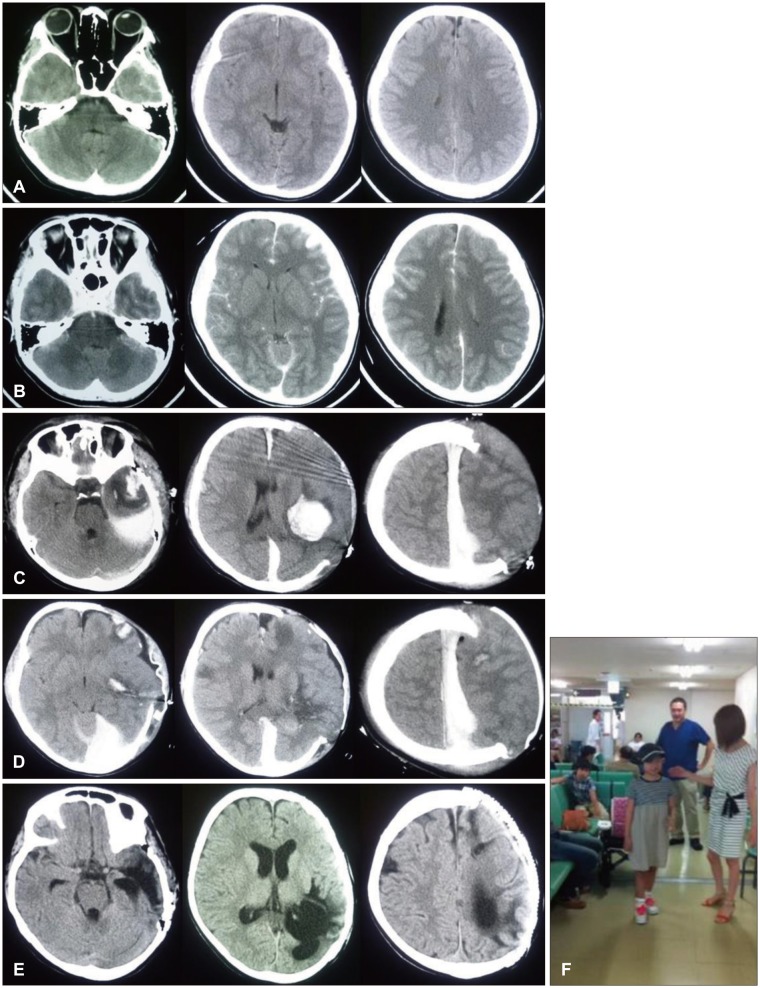Korean J Neurotrauma.
2018 Apr;14(1):6-13. 10.13004/kjnt.2018.14.1.6.
Efficacy of the All-in-One Therapeutic Strategy for Severe Traumatic Brain Injury: Preliminary Outcome and Limitation
- Affiliations
-
- 1Department of Neurosurgery, Nara Medical University, Nara, Japan. park-y-s@naramed-u.ac.jp
- KMID: 2410914
- DOI: http://doi.org/10.13004/kjnt.2018.14.1.6
Abstract
OBJECTIVE
Despite recent advances in medicine, no significant improvement has been achieved in therapeutic outcomes for severe traumatic brain injury (TBI). In the treatment of severe multiple traumas, accurate judgment and prompt action corresponding to rapid pathophysiological changes are required. Therefore, we developed the "All-in-One" therapeutic strategy for severe TBI. In this report, we present the therapeutic concept and discuss its efficacy and limitations.
METHODS
From April 2007 to December 2015, 439 patients diagnosed as having traumatic intracranial injuries were treated at our institution. Among them, 158 patients were treated surgically. The "All-in-One" therapeutic strategy was adopted to enforce all selectable treatments for these patients at the initial stages. The outline of this strategy is as follows: first, prompt trepanation surgery in the emergency room (ER); second, extensive decompression craniotomy (DC) in the operating room (OR); and finally, combined mild hypothermia and moderate barbiturate (H-B) therapy for 3 to 5 days. We performed these approaches on a regular basis rather than stepwise rule. If necessary, internal ecompression surgery and external ventricular drainage were performed in cases in which intracranial pressure could not be controlled.
RESULTS
Trepanation surgery in the ER was performed in 97 cases; among these cases, 46 had hematoma removal surgery and also underwent DC in the OR. Craniotomy was not enforced unless the consciousness level and pupil findings did not improve after previous treatments. H-B therapy was administered in 56 cases. Internal decompression surgery, including evacuation of traumatic intracerebral hematoma, was additionally performed in 12 cases. Three months after injury, the Glasgow Outcome Scale (GOS) score yielded the following results: good recovery in 25 cases (16%), mild disability in 28 (18%), severe disability in 33 (21%), persistent vegetative state in 9 (6%), and death in 63 (40%). Furthermore, 27 (36%) of the 76 most severe patients who had an abnormal response of bilateral eye pupils were life-saving. Because many cases of a GOS score of ≤5 are included in this study, this result must be satisfactory.
CONCLUSION
This therapeutic strategy without any lose in the appropriate treatment timing can improve the outcomes of the most severe TBI cases. We think that the breakthrough in the treatment of severe TBI will depend on the shift in the treatment policy.
Keyword
MeSH Terms
Figure
Reference
-
1. Andrews BT, Pitts LH. Functional recovery after traumatic transtentorial herniation. Neurosurgery. 1991; 29:227–231. PMID: 1886660.
Article2. Andrews PJ, Sinclair HL, Rodriguez A, Harris BA, Battison CG, Rhodes JK, et al. Hypothermia for intracranial hypertension after traumatic brain injury. N Engl J Med. 2015; 373:2403–2412. PMID: 26444221.
Article3. Beck B, Gantner D, Cameron PA, Braaf S, Saxena M, Cooper DJ, et al. Temporal trends in functional outcomes after severe traumatic brain injury: 2006-2015. J Neurotrauma. 2018; 15:1021–1029.
Article4. Bor-Seng-Shu E, Figueiredo EG, Amorim RL, Teixeira MJ, Valbuza JS, de Oliveira MM, et al. Decompressive craniectomy: a meta-analysis of influences on intracranial pressure and cerebral perfusion pressure in the treatment of traumatic brain injury. J Neurosurg. 2012; 117:589–596. PMID: 22794321.
Article5. Bullock MR, Chesnut R, Ghajar J, Gordon D, Hartl R, Newell DW, et al. Surgical management of acute subdural hematomas. Neurosurgery. 2006; 58:S16–S24. PMID: 16710968.
Article6. Busto R, Globus MY, Dietrich WD, Martinez E, Valdés I, Ginsberg MD. Effect of mild hypothermia on ischemia-induced release of neurotransmitters and free fatty acids in rat brain. Stroke. 1989; 20:904–910. PMID: 2568705.
Article7. Carney N, Totten AM, O'Reilly C, Ullman JS, Hawryluk GW, Bell MJ, et al. Guidelines for the management of severe traumatic brain injury, fourth edition. Neurosurgery. 2017; 80:6–15. PMID: 27654000.
Article8. Clifton GL, Miller ER, Choi SC, Levin HS, McCauley S, Smith KR Jr, et al. Lack of effect of induction of hypothermia after acute brain injury. N Engl J Med. 2001; 344:556–563. PMID: 11207351.
Article9. Clifton GL, Valadka A, Zygun D, Coffey CS, Drever P, Fourwinds S, et al. Very early hypothermia induction in patients with severe brain injury (the National Acute Brain Injury Study: Hypothermia II): a randomised trial. Lancet Neurol. 2011; 10:131–139. PMID: 21169065.
Article10. Cooper DJ, Rosenfeld JV, Murray L, Arabi YM, Davies AR, D'Urso P. Decompressive craniectomy in diffuse traumatic brain injury. N Engl J Med. 2011; 364:1493–1502. PMID: 21434843.
Article11. Haselsberger K, Pucher R, Auer LM. Prognosis after acute subdural or epidural haemorrhage. Acta Neurochir (Wien). 1988; 90:111–116. PMID: 3354356.
Article12. Huang AP, Tu YK, Tsai YH, Chen YS, Hong WC, Yang CC, et al. Decompressive craniectomy as the primary surgical intervention for hemorrhagic contusion. J Neurotrauma. 2008; 25:1347–1354. PMID: 19061378.
Article13. Iida K, Kurisu K, Arita K, Ohtani M. Hyperemia prior to acute brain swelling during rewarming of patients who have been treated with moderate hypothermia for severe head injuries. J Neurosurg. 2003; 98:793–799. PMID: 12691404.
Article14. Leitgeb J, Mauritz W, Brazinova A, Janciak I, Majdan M, Wilbacher I, et al. Outcome after severe brain trauma due to acute subdural hematoma. J Neurosurg. 2012; 117:324–333. PMID: 22631691.
Article15. Mahoney BD, Rockswold GL, Ruiz E, Clinton JE. Emergency twist drill trephination. Neurosurgery. 1981; 8:551–554. PMID: 7266793.
Article16. Matsushima K, Inaba K, Siboni S, Skiada D, Strumwasser AM, Magee GA, et al. Emergent operation for isolated severe traumatic brain injury: Does time matter? J Trauma Acute Care Surg. 2015; 79:838–842. PMID: 26317818.17. Nakamura T, Miyamoto O, Yamagami S, Hayashida Y, Itano T, Nagao S. Influence of rewarming conditions after hypothermia in gerbils with transient forebrain ischemia. J Neurosurg. 1999; 91:114–120. PMID: 10389889.
Article18. Olivecrona M, Rodling-Wahlström M, Naredi S, Koskinen LO. Effective ICP reduction by decompressive craniectomy in patients with severe traumatic brain injury treated by an ICP-targeted therapy. J Neurotrauma. 2007; 24:927–935. PMID: 17600510.
Article19. Onuma T, Kameyama M, Shimosegawa Y, Shiina G. One burr hole surgery in the emergency room for traumatic extracerebral hematoma. Neurotraumatology. 1993; 16:161–166.20. Park YS, Ishikawa J. Analysis of mild barbiturate-moderate hypothermia therapy on the authors' 152 cases. No Shinkei Geka. 1997; 25:529–535. PMID: 9181590.21. Park YS, Ishikawa J. Wide craniotomy-small dural incisions and intentionally delayed removal of intracerebral contusional hemorrhage for acute subdural hematoma. No Shinkei Geka. 1997; 25:1081–1089. PMID: 9430142.22. Park YS, Ishikawa J. Clinical result of moderate hypothermia therapy in patients with ruptured cerebral aneurysm. Jpn J Neurosurg. 1998; 7:71–78.
Article23. Salottolo K, Carrick M, Levy AS, Morgan BC, Mains CW, Slone DS, et al. Aggressive operative neurosurgical management in patients with extra-axial mass lesion and Glasgow Coma Scale of 3 is associated with survival benefit: A propensity matched analysis. Injury. 2016; 47:70–76. PMID: 26499227.
Article24. Seelig JM, Becker DP, Miller JD, Greenberg RP, Ward JD, Choi SC. Traumatic acute subdural hematoma: major mortality reduction in comatose patients treated within four hours. N Engl J Med. 1981; 304:1511–1518. PMID: 7231489.25. Shimoda K, Maeda T, Tado M, Yoshino A, Katayama Y, Bullock MR. Outcome and surgical management for geriatric traumatic brain injury: analysis of 888 cases registered in the Japan Neurotrauma Data Bank. World Neurosurg. 2014; 82:1300–1306. PMID: 25128777.
Article26. Stein SC, Georgoff P, Meghan S, Mizra K, Sonnad SS. 150 years of treating severe traumatic brain injury: a systematic review of progress in mortality. J Neurotrauma. 2010; 27:1343–1353. PMID: 20392140.
Article27. Suehiro E, Koizumi H, Kunitsugu I, Fujisawa H, Suzuki M. Survey of brain temperature management in patients with traumatic brain injury in the Japan neurotrauma data bank. J Neurotrauma. 2014; 31:315–320. PMID: 24047191.
Article28. Tien HC, Jung V, Pinto R, Mainprize T, Scales DC, Rizoli SB. Reducing time-to-treatment decreases mortality of trauma patients with acute subdural hematoma. Ann Surg. 2011; 253:1178–1183. PMID: 21494125.
Article29. Timofeev I, Czosnyka M, Nortje J, Smielewski P, Kirkpatrick P, Gupta A, et al. Effect of decompressive craniectomy on intracranial pressure and cerebrospinal compensation following traumatic brain injury. J Neurosurg. 2008; 108:66–73. PMID: 18173312.
Article30. Xu RX, Nakamura T, Nagao S, Miyamoto O, Jin L, Toyoshima T, et al. Specific inhibition of apoptosis after cold-induced brain injury by moderate postinjury hypothermia. Neurosurgery. 1998; 43:107–114. PMID: 9657196.
Article
- Full Text Links
- Actions
-
Cited
- CITED
-
- Close
- Share
- Similar articles
-
- Animal Models of Traumatic Brain Injury
- Controversies in Acute Care of Patients with Severe Traumatic Brain Injury
- Status Quo of Severe Head Injury Management
- Target temperature management in traumatic brain injury with a focus on adverse events, recognition, and prevention
- Comparison of Prognosis between the Hypoxic-Hypotensive Brain Injured and Traumatic Brain Injured Patients



